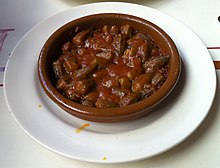Bamia
 Bamia stew | |
| Alternative names | Bamieh, Bamya |
|---|---|
| Course | Meal |
| Region or state | Cyprus, Egypt, Greece, Iran, Iraq, Israel, Jordan, Lebanon, Palestine, Sudan, Syria, Turkey |
| Main ingredients | lamb meat, okra, bay leaves, salt, pepper |
Bamia (Arabic: بامية, cooked okra; Greek: μπάμια; Turkish: bamya[1]), or bamia bi-lahm (Arabic: البامية باللحم أو شوربة البامية okra with meat), is a Middle Eastern, Anatolian and Greek stew prepared using lamb, okra and tomatoes as primary ingredients.[2][3][4] Additional ingredients used include tomato sauce, onion, garlic, cilantro (coriander), vegetable oil, cardamom, salt and pepper.[2] The word "bamia" itself simply means "okra" and it is etymologically an Arabic word.[5]
Bamia is very popular during fasting seasons such as Easter in Greece and Cyprus.[citation needed]
Regional variations
In Turkey, bamia (natively bamya) is an Anatolian stew that has a sweet and sour flavor.[6] It is prepared using okra, lemon juice, olive oil, sugar, salt and pepper.[6] Turkish bamia is sometimes served as a palate cleanser between food courses at ceremonial feasts.[6]
In Egypt, sinew (tendons) of lamb are typically used, which can endure long cooking times.[7] Ta'aleya, an Egyptian garlic sauce, is used as an ingredient to add flavor to bamia.[a][7]
In Iran, bāmieh is served as a khoresh along with rice and is a popular dish in the southern provinces.[citation needed]
See also
Notes
References
- ^ Turkey. Michelin Travel Publications. 2000. p. 94.
- ^ a b Webb, L.S.; Roten, L.G. (2009). The Multicultural Cookbook for Students. EBL-Schweitzer. ABC-CLIO. pp. 286–287. ISBN 978-0-313-37559-0.
- ^ Kopka, D. (2011). Passport Series: Middle East. Passport Series. Lorenz Educational Press. p. 70. ISBN 978-0-7877-8716-5.
- ^ Claudia Roden, A New Book of Middle Eastern Food, p. 248
- ^ "Bamya". Nişanyan Sözlük. Retrieved 2019-11-01.
{{cite web}}: CS1 maint: url-status (link) - ^ a b c Basan, G.; Basan, J. (2007). Middle Eastern Kitchen. Hippocrene Books. p. 225. ISBN 978-0-7818-1190-3.
- ^ a b Smith, A. (2013). The Oxford Encyclopedia of Food and Drink in America. The Oxford Encyclopedia of Food and Drink in America. OUP USA. p. 678. ISBN 978-0-19-973496-2. Retrieved September 6, 2016.
- ^ "New Statesman". Volume 113. Statesman and Nation Publishing Company. 1987. p. 36.
